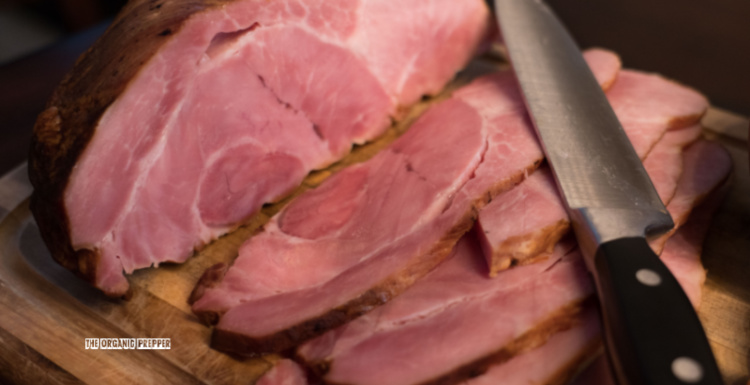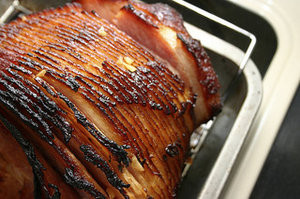If you're new here, you may want to subscribe to my RSS feed. Thanks for visiting!
By the author of The Prepper’s Canning Guide
(Originally published January 7, 2013.) In a totally different stratosphere from Spam, the cans of flaked ham and the big pear-shaped cans of ham that you get from the grocery store, is home-canned ham.
(You can learn to can all of your holiday leftovers and much more in my book, The Prepper’s Canning Guide)
At Christmas I got a spiral-cut, naturally cured ham. It was pricy, but very delicious. I baked it in a nice orange-brown sugar glaze and we picked away at it for a few days.
In order to get our money’s worth, today I spent several hours canning the leftovers and making broth for canning also.
I started with this rather motley looking piece of ham on the bone.
Using a sharp knife remove as much ham as possible from the bone. Place the pieces into sanitized jars.
The fattier pieces that you won’t want to eat can be put aside for broth.
I filled pint jars to the top with ham pieces and placed about 1 inch of ham in the bottom of some quart jars. I filled the quart jars the rest of the way up with pinto and navy beans, a bay leaf, onion, and garlic.
When I made the ham initially, I reserved the liquid from cooking it. While I was prepping the ham for canning, this liquid was coming to a boil. Once the jars are filled, ladle the hot broth in, leaving 1 inch of headspace. If you don’t have broth, you can use water or chicken broth for this. Wipe the lip of the jar with a cloth dipped in vinegar and lid the jars. Pressure can for 90 minutes for quarts at 10 PSI, adjusting for altitude. (Process pints for 75 minutes)
Meanwhile, I used part of the ham bone to make homemade pork and beans for dinner. In the pot are pinto and white beans, dehydrated yellow peppers, onions, garlic and a bay leaf. This was left to simmer all afternoon. In another pot (boy was my stove loaded today!) I placed the rest of the hambone and the less than appetizing bits of meat in water to make broth. Click HERE to learn how to can homemade pork and beans.
(If you want to learn more about preserving your own food, make sure you check out our free QUICKSTART Guide to home canning.)
The ham broth resulted in 4 more pints of broth that were processed for 75 minutes in the pressure canner.
The end result of the day was 4 pints of ham broth, 4 pints of sliced ham in broth, and 3 quarts of ham and beans.
USES:
- The flavor of the ham becomes much more intense as it sits in the jar. Be careful about adding salt when you open the jar and add the ham to another food you are preparing.
- The ham and beans make a good base for pork and beans in barbecue sauce or for a bean soup (just add to broth).
- The ham pieces can be sauteed and added to scrambled eggs or in place of bacon to top baked potatoes or soup.
- The ham and broth can be used to make red-eye gravy.
- The ham pieces can also be used in casseroles and scalloped potatoes.
- The broth is a delicious base for soups, cooking rice or wheat berries, or for cooking beans or other legumes.
This recipe is from The Prepper’s Canning Guide, my new book with instructions for canning more than 80 different foods.
What are your favorite ways to preserve your leftovers from holidays? Are there particular recipes you use to ensure that you waste as little as possible? Perhaps you have a unique way of “recycling” your holiday meals over the following weeks? Let us know your tips and tricks in the comments below.
About Daisy
Daisy Luther is a coffee-swigging, adventure-seeking, globe-trotting blogger. She is the founder and publisher of three websites. 1) The Organic Prepper, which is about current events, preparedness, self-reliance, and the pursuit of liberty; 2) The Frugalite, a website with thrifty tips and solutions to help people get a handle on their personal finances without feeling deprived; and 3) PreppersDailyNews.com, an aggregate site where you can find links to all the most important news for those who wish to be prepared. Her work is widely republished across alternative media and she has appeared in many interviews.
Daisy is the best-selling author of 5 traditionally published books, 12 self-published books, and runs a small digital publishing company with PDF guides, printables, and courses at SelfRelianceand Survival.com You can find her on Facebook, Pinterest, Gab, MeWe, Parler, Instagram, and Twitter.

















15 Responses
This is a great article and timely. Your photos are really helpful, too. I have been canning bacon with great success and wanted to do more pork—we love pea soup and pulled pork on biscuits. I bought a half pig this fall and have a huge uncured ham in the freezer that I have been afraid to tackle until now. One question: are you canning pints and quarts together at the same time as seen in the processor in one photo?
Sally – yes, I’m canning them together as shown in the photo – I just go with the longer canning time. I’ve never had a problem processing the pints for the extra 15 minutes but I wouldn’t do it with something more delicate, like veggies. Good luck with the ham – one note – it gets much saltier as it sits in the jar – I’ll update the article to reflect that as well – so take care when seasoning whatever dish you are making with it.
We bought a freshly killed half pig too. The two big pieces of ham is still being marinated in salt in the cellar. We will smoke them up in the chimney in a week or two. Then the smoked ham will last ‘forever’ hanging in the pantry.
Can you send me details on exactly how you marinate in salt (amounts of pork, amounts of salt, types of salt, etc.) When you say “smoke them up in the chimney”, what do you mean (smoker?). What is your estimated life date (e.g. I have food that lasts 30 years). Thanks,
Hubby and i are big bean (all types), rice and soup (all types) eaters. I will enjoy trying this when i get a canning pot! Red eye gravy is delicious, and i love it on smashed potatoes. recently i learned how to make them with mix of white and sweet potatoes. dear Lord, i died and went to heaven when i put Red Eye gravy on it!!
I am very interested in your advice about canning meat and other foods. Thank you in advance for the good information.
My question to you is, It appears to me that the beans in your jars were not cooked beans, is this true? If so would you please explain to me the reasoning behind this, and could it be done both cooked and dried? If not why not?
Mystery ~
Hi. Beans can be canned already cooked, or you can soak them overnight before canning, and then they will cook during the processing time. I often do it that way for two reasons. 1) I’m kind of lazy and 2) it uses less power since they have to be processed for 90 minutes whether they are pre-cooked or not.
You aren’t alone in your question – I got lots of questions about canning beans so I wrote an article about that. (I should update this article to add the link!)
https://www.theorganicprepper.com/how-to-can-pork-and-beans-02242013
Check that out and please let me know if you have any further questions!
Happy Canning!
Daisy
to sally,you said your ham was uncured which means it will not be salty or smokey it will be like pork roast but out of the ham portion of a pig.( best part)could some one give recipe for red eye gravy mom never made it!Joanne
Can the ham already be cooked or will that just over cook it? And what is the shelf life of canned ham? This is my first time canning meats. Little scared! Don’t want to die from bad canned meat. lol thanks Sheryl
Hi Sheryl ~
Yes – it can already be cooked. Generally I can leftover ham. The shelf life according to the USDA is one year. We have been eating home-canned ham for years with no ill effects. 🙂
~ Daisy
In the ham and white bean receipie at the top of the page are the beans dry? Un-soaked? Just as is? If so thats awesome!!!!
Excellent piece. I see your book on Amazon and well reviewed. Put it in my shopping cat. Question: Is the pressure canner mandatory for canning an already cooked ham? Seems like a lot more cooking is taking place during the canning process.
Hi Jim! Thank you for ordering my book.
Yes, the pressure canner is necessary any time you are canning meat or some other low-acid food. If you don’t pressure can, you run the risk of botulism, which can cause incurable neurological issues, or even kill you. More cooking definitely does take place, but for your safety, it has to be done.
Our local grocery had shank end hams for $.97 lb so I got 3. I’ve already canned one. I got 13 – 12 oz jars of ham and a pint of ham fat from cooking the broth. Number 2 was fixed yesterday for the fam. I’ll cook this bone and the number 3 one and can that up too. Meat for a dollar a pound is hard to come by! I’ll most likely use it in my breakfast eggs and for ham salad. P.S. I have you canning book Daisy and have canned several of your recipes.
This appears to be an old post, however the date at the top is April 18, 2022. I bought 2 8lb. Hickory Smoked boneless Honey Hams, in hopes of canning them. But it seems that I may not be able to do that. Your article gave me hope, however. Could you please provide me with directions if that is possible. I was planning on cutting the ham into small dices, to add to scrambled eggs, soups, etc. later. If canning is not an option, what about dehydrating. I now have 16 lbs. of ham, and no freezer room. Help!